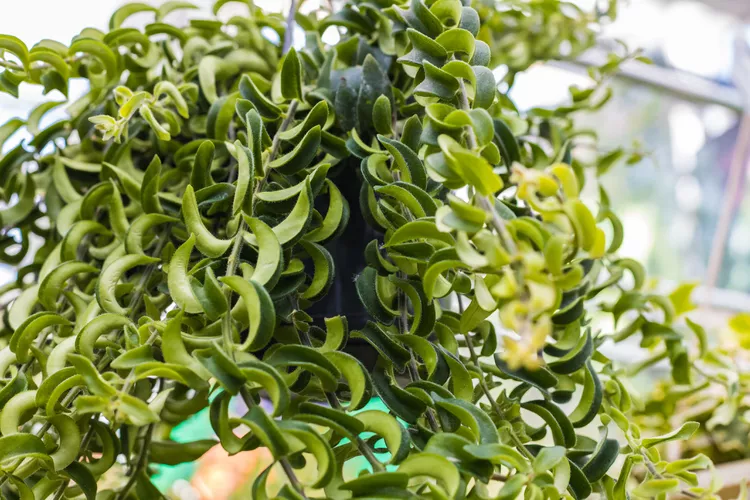The twisted lipstick plant, an eye-catching variety of the lipstick plant (Aeschynanthus radicans), has long been a popular houseplant, prized for its long trailing stems covered in uniquely twisted leaves and red, lipstick-shaped flowers. Native to Southeast Asia, lipstick plants naturally grow high up in the trees as epiphytes and on cliffside as lithophytes, where they grow among leaf litter. Most types of lipstick plants easily adapt to indoor conditions and can live for many years as a houseplant. Follow this guide to learn how to grow and care for twisted lipstick plants indoors.
Twisted Lipstick Plant Overview
| Genus Name | Aeschynanthus radicans |
| Common Name | Twisted Lipstick Plant |
| Plant Type | Houseplant, Perennial |
| Light | Shade |
| Height | 2 to 3 feet |
| Width | 6 to 12 inches |
| Flower Color | Orange, Red |
| Foliage Color | Blue/Green |
| Propagation | Stem Cuttings |
Twisted Lipstick Plant Care Tips
Light
Bright, indirect light to mimic the lipstick plant’s native habitat in forests is best and will keep the plants full and healthy enough to bloom. However, plants exposed to direct sun have a tendency to burn and plants in light that's too dim will cease to bloom and may become leggy.
Soil and Water
In their native habitat, lipstick plants grow on the mossy branches of tall trees and among rocks where leaf litter has formed a little soil. To keep plants healthy, provide a loamy, well-draining potting mix and keep the soil just barely damp.
When watering your twisted lipstick plant, soak the soil thoroughly and allow it to dry before the next watering. Plants in overly wet soil may rot.
Temperature and Humidity
Twisted lipstick plants prefer tropical conditions with ample warmth and humidity. However, they adapt well to household conditions provided temperatures remain above 65°F during the day and do not regularly drop below 60°F at night.
If humidity is too low, twisted lipstick plants may develop browning leaf edges and leaf and flower drop, leaving stems bare. Locating plants in more humid areas of the house such as the kitchen and bathroom will help to maintain humidity. You can also place a humidifier nearby.
Fertilizer
As epiphytes, your twisted lipstick plant will not require large amounts of fertilizer. However, your plant will benefit from a little fertilizer while actively growing or flowering. Use a houseplant fertilizer at half strength or an organic fertilizer such as fish or kelp emulsion every third watering.
Pruning
While pruning your twisted lipstick plants is not entirely necessary, some trimming of broken, scraggly, or old stems can improve the plant’s overall appearance and potentially lead to a fuller, leafier plant.
Pest and Problems
Twisted lipstick plants are hardy and seldom have issues, but they are prone to root rot when left in overly wet soils and when temperatures remain too cool–especially while plants are not actively growing. Proper watering, a well-draining soil mix, and warm temperatures will keep plants from developing rot.
Pests can also be an issue for lipsticks plants, primarily mealybugs and spider mites. Both pests can be taken care of by using pyrethrin (for the mealybugs), neem oil, or insecticidal soaps. Regular washing of the entire plant in a sink or shower with warm water can also help to eliminate pests.
Propagating Twisted Lipstick Plants
Lipstick plants can easily be propagated from stem cuttings by following a few simple steps:
- Use a clean pair of scissors or shears to remove healthy, non-blooming stems from an existing plant. Cut sections of about 6 inches per cutting and remove all but one or two leaves.
- Prepare a mixture of three-quarters perlite to one-quarter potting soil and place in containers to use for cuttings.
- Dip about 1 inch of each stem into a rooting hormone powder.
- Using a pencil or your finger, create a hole large enough to fit about a third of the cuttings into the soil.
- Place the cutting into the hole, being careful not to knock off rooting hormone as you do so. Fill in holes around each stem with additional mix.
- Water plants and keep them in a warm, humid location with bright, indirect lighting. A warming mat designed for seed starting can help promote root growth.
Types of Lipstick Plants
Lipstick Vine
A cousin of the twisted lipstick plant, lipstick vine (Aeschynanthus pulcher) also produces red flowers.
Basket Vine
Another plant that is often confused with the lipstick plant while not in bloom, the basket vine (Aeschynanthus speciosus) produces long, trailing stems, but with bright orange flowers that fade to yellow and green at their base.
Variegated Lipstick Plant
This plant looks identical in all aspects to the straight species, but the leaves of variegated lipstick plant (Aeschynanthus radicans 'Variegata') are mottled white and cream.
Curly Lipstick Plant
This variety of lipstick plant (Aeschynanthus radicans 'Curly') is often confused with the twisted lipstick plant, but instead of producing contorted leaves, this cultivar produces gently curled leaves giving it a tidier appearance.




















